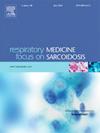Overlap syndromes in sarcoidosis: Unveiling the masquerader
IF 3.5
3区 医学
Q2 CARDIAC & CARDIOVASCULAR SYSTEMS
引用次数: 0
Abstract
As a multi system granulomatous disease, clinical presentations of sarcoidosis are highly variable. In the absence of a stereotypical clinical presentation such as asymptomatic bilateral hilar adenopathy, Lofgren's syndrome, or lupus pernio, a diagnosis of sarcoidosis typically requires 1) compatible clinical presentation, 2) histologic evidence of granulomatous inflammation, and 3) the exclusion of other causes. The clinical presentation of sarcoidosis is often nonspecific and a variety of other causes of granulomatous inflammation can make diagnosing sarcoidosis a challenge for clinicians. “Overlap syndromes” are often used to describe clinical presentations of sarcoidosis that share histologic and clinical features of other diseases, or when the diagnosis of sarcoidosis is made in association with the coexistence of another diagnosis with similar clinical or histologic findings. Because of the risk of diagnostic delay and diagnostic errors, it is vital for clinicians to be familiar with overlap syndromes in sarcoidosis. The coexistence of sarcoidosis with other diseases can also significantly impact disease management and outcomes. This article will review the most current published data on overlap syndromes in sarcoidosis to aid clinicians in diagnosing and managing these complex patients.
肉样瘤病的重叠综合征:揭开伪装者的面纱。
肉样瘤病是一种多系统肉芽肿性疾病,临床表现千变万化。如果没有典型的临床表现,如无症状的双侧肺部腺病、洛夫格伦综合征或狼疮周身症,肉样瘤病的诊断通常需要:1)符合的临床表现;2)肉芽肿性炎症的组织学证据;3)排除其他病因。肉样瘤病的临床表现通常没有特异性,而且肉芽肿性炎症的病因多种多样,这给临床医生诊断肉样瘤病带来了挑战。"重叠综合征 "经常被用来描述肉样瘤病的临床表现与其他疾病的组织学和临床特征相同,或者当肉样瘤病的诊断与具有类似临床或组织学发现的其他诊断同时存在时。由于存在诊断延误和诊断错误的风险,临床医生必须熟悉肉样瘤病的重叠综合征。肉样瘤病与其他疾病并存也会对疾病的治疗和预后产生重大影响。本文将回顾最新发表的有关肉样瘤病重叠综合征的数据,以帮助临床医生诊断和管理这些复杂的患者。
本文章由计算机程序翻译,如有差异,请以英文原文为准。
求助全文
约1分钟内获得全文
求助全文
来源期刊

Respiratory medicine
医学-呼吸系统
CiteScore
7.50
自引率
0.00%
发文量
199
审稿时长
38 days
期刊介绍:
Respiratory Medicine is an internationally-renowned journal devoted to the rapid publication of clinically-relevant respiratory medicine research. It combines cutting-edge original research with state-of-the-art reviews dealing with all aspects of respiratory diseases and therapeutic interventions. Topics include adult and paediatric medicine, epidemiology, immunology and cell biology, physiology, occupational disorders, and the role of allergens and pollutants.
Respiratory Medicine is increasingly the journal of choice for publication of phased trial work, commenting on effectiveness, dosage and methods of action.
 求助内容:
求助内容: 应助结果提醒方式:
应助结果提醒方式:


